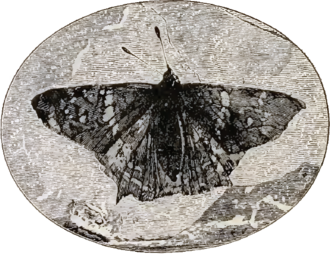Butterfly
(Redirected from Butterflies)
Butterflies are insects in the macrolepidopteran clade Rhopalocera from the order Lepidoptera, which also includes moths. Adult butterflies have large, often brightly coloured wings, and conspicuous, fluttering flight. The group comprises the true butterflies (superfamily Papilionoidea), the skippers (superfamily Hesperioidea), and the moth-butterflies (superfamily Hedyloidea). Butterfly fossils date to the Paleocene, about 56 million years ago.
Butterflies exhibit a wide range of ecological adaptations including diurnal activity and they have a wide range of interactions with other organisms such as pollinators while others are pests of agricultural crops. Butterflies play an important role in the ecosystem as pollinators and as a part of the food chain.
Anatomy
Butterflies are characterized by their four scale-covered wings, which give them their distinctive colors and patterns. These scales are tiny sensory hairs that are pigmented with melanins that give them blacks and browns, as well as uric acid derivatives, flavones, and carotenoids that give them yellows and oranges, while some blues, greens, reds, and iridescence are created structurally through the microstructure of the scales and hairs.
Like all insects, butterflies have a three-part body: the head, thorax, and abdomen. The head features two large compound eyes, a pair of antennae, and a proboscis. The thorax is where the wings and six legs are attached, and the abdomen contains the digestive and reproductive organs.
Life Cycle
The butterfly life cycle is a four-stage process known as metamorphosis, which includes egg, larva (caterpillar), pupa (chrysalis), and adult stages. The duration of the butterfly lifecycle varies greatly depending on the species.
1. Egg: A female butterfly lays eggs on the leaves of plants. 2. Larva: The egg hatches into a caterpillar, which feeds on the host plant. 3. Pupa: After reaching a certain size, the caterpillar forms a chrysalis or pupa. 4. Adult: A fully developed butterfly emerges from the chrysalis, and after its wings dry, it can begin to fly.
Conservation
Butterfly populations are declining worldwide due to habitat loss, climate change, pollution, and the use of pesticides. Conservation efforts include protecting habitats, promoting butterfly-friendly gardening practices, and establishing butterfly reserves. The Monarch butterfly migration is one of the most spectacular phenomena in the butterfly world, and it has been the subject of conservation efforts due to its declining population.
Cultural Significance
Butterflies have been a symbol of change, joy, and life in various cultures throughout history. They are a popular subject in the visual and literary arts. In some cultures, butterflies are believed to carry the souls of the dead or represent transformation and rebirth.
Transform your life with W8MD's budget GLP-1 injections from $125.
W8MD offers a medical weight loss program to lose weight in Philadelphia. Our physician-supervised medical weight loss provides:
- Most insurances accepted or discounted self-pay rates. We will obtain insurance prior authorizations if needed.
- Generic GLP1 weight loss injections from $125 for the starting dose.
- Also offer prescription weight loss medications including Phentermine, Qsymia, Diethylpropion, Contrave etc.
NYC weight loss doctor appointments
Start your NYC weight loss journey today at our NYC medical weight loss and Philadelphia medical weight loss clinics.
- Call 718-946-5500 to lose weight in NYC or for medical weight loss in Philadelphia 215-676-2334.
- Tags:NYC medical weight loss, Philadelphia lose weight Zepbound NYC, Budget GLP1 weight loss injections, Wegovy Philadelphia, Wegovy NYC, Philadelphia medical weight loss, Brookly weight loss and Wegovy NYC
|
WikiMD's Wellness Encyclopedia |
| Let Food Be Thy Medicine Medicine Thy Food - Hippocrates |
Medical Disclaimer: WikiMD is not a substitute for professional medical advice. The information on WikiMD is provided as an information resource only, may be incorrect, outdated or misleading, and is not to be used or relied on for any diagnostic or treatment purposes. Please consult your health care provider before making any healthcare decisions or for guidance about a specific medical condition. WikiMD expressly disclaims responsibility, and shall have no liability, for any damages, loss, injury, or liability whatsoever suffered as a result of your reliance on the information contained in this site. By visiting this site you agree to the foregoing terms and conditions, which may from time to time be changed or supplemented by WikiMD. If you do not agree to the foregoing terms and conditions, you should not enter or use this site. See full disclaimer.
Credits:Most images are courtesy of Wikimedia commons, and templates, categories Wikipedia, licensed under CC BY SA or similar.
Translate this page: - East Asian
中文,
日本,
한국어,
South Asian
हिन्दी,
தமிழ்,
తెలుగు,
Urdu,
ಕನ್ನಡ,
Southeast Asian
Indonesian,
Vietnamese,
Thai,
မြန်မာဘာသာ,
বাংলা
European
español,
Deutsch,
français,
Greek,
português do Brasil,
polski,
română,
русский,
Nederlands,
norsk,
svenska,
suomi,
Italian
Middle Eastern & African
عربى,
Turkish,
Persian,
Hebrew,
Afrikaans,
isiZulu,
Kiswahili,
Other
Bulgarian,
Hungarian,
Czech,
Swedish,
മലയാളം,
मराठी,
ਪੰਜਾਬੀ,
ગુજરાતી,
Portuguese,
Ukrainian
Contributors: Prab R. Tumpati, MD





